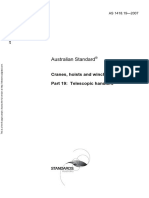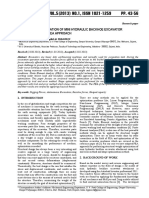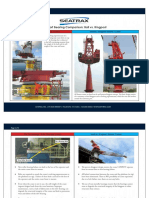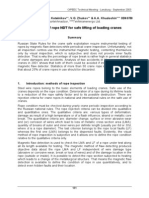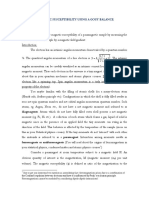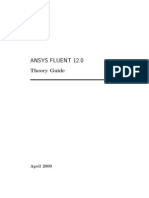Optimization of Telescopic Boom
Optimization of Telescopic Boom
Uploaded by
Vinod YbCopyright:
Available Formats
Optimization of Telescopic Boom
Optimization of Telescopic Boom
Uploaded by
Vinod YbOriginal Description:
Copyright
Available Formats
Share this document
Did you find this document useful?
Is this content inappropriate?
Copyright:
Available Formats
Optimization of Telescopic Boom
Optimization of Telescopic Boom
Uploaded by
Vinod YbCopyright:
Available Formats
Weight Optimization of Extensible boom of
Telescopic Hydraulic Crane
Nilesh P. Darji, Atul Deshmukh and P.D. Solanki
L.D.College of Engineering, Ahemedabad, India.
Tecso Technology Solution, Baroda, India.
nilesh_me2008@yahoo.com
atul_301077@yahoo.com
purnikkumar@yahoo.com
Abstract- In this paper we have done the Finite
Element Analysis and weight reduction of Extensible
telescopic boom of Telescopic hydraulic crane using
Finite Element Analysis Software Ansys. Previous
work has been done on this type of crane or crane
structure is up to stress analysis using more than one
element in the Finite Element Analysis. Here we find
out the maximum stress induced in the boom model
with the max load carrying capacity according to the
loading chart prepared using SAEJ1078 standards
and kinematic force calculation software Design
View. This stress result is less than Yield and
ultimate strength of the material so we have option to
optimize the total weight of the boom. After reducing
weight of the boom we have done the stress analysis
again under same condition of loading as before
reduce weight and we got the maximum stress result
is still less than the yield and ultimate strength of the
material . As a result of this study further weight
reduction of the off highway vehicles and their
structures is proposed so we can minimize the overall
manufacturing cost by saving the expenditure on the
material. Model taken in this paper is Autogru 160.30
of an Italian Company Eurogru Amici. The analysis
has been done at the company Tecso Technology
Solution, Baroda.
KEYWORDS: - Telescopic Hydraulic Crane, boom,
FEA, Optimization, Design View.
rescue jobs, lifting boats in and out of the water, etc. The
relative compactness of telescopic booms make them
adaptable for many mobile applications. Boom play
objective role in the load lifting operation and the
maximum direct effect of the stress is initializing from it
and effects to another attached assemblies of crane Some
times this crane are truck mounted to travel on highway
and eliminating the need of the special transportation for
crane.
Generally, these cranes are able to travel on highways,
eliminating the need for special equipment to transport the
crane. When working on the jobsite, outriggers are
extended horizontally from the chassis then vertically to
level and stabilize the crane while stationary and hoisting
Many truck cranes have slow-travelling capability (a few
miles per hour) while suspending a load. Great care must
be taken not to swing the load sideways from the direction
of travel, as most anti-tipping stability then lies in the
stiffness of the chassis suspension. Most cranes of this type
also have moving counterweights for stabilization beyond
that provided by the outriggers. Loads suspended directly
aft are the most stable, since most of the weight of the
crane acts as a counterweight. Factory-calculated charts (or
electronic safeguards) are used by crane operators to
determine the maximum safe loads for stationary
(outriggers ) work as well as (on-rubber) loads and
travelling speeds. This paper is a part of analysis and
optimization using the stress result getting from structural
analysis of telescopic hydraulic crane using ANSYS
11.0(FEA Software).
1. INTRODUCTION
A telescopic hydraulic crane has a boom that
consists of a number of tubes fitted one inside the
other. A hydraulic or other powered mechanism
extends or retracts the tubes to increase or decrease
the total length of the boom. These types of booms
are often used for short term construction projects,
In this paper we have studied one step further than
previous authors work did up to analysis and modeling.
This paper represent the overall manufacturing cost
reduction by use of weight optimized model keeping the
same limit for the stress produced at the time of loading. In
this paper also incorporate one kinematic force calculation
software DESIGN VIEW which is very useful for the force
calculation for off highway vehicles.
2. EXTENSIBLE BOOM MODEL
3. FORCE CALCULATION USING DESIGN VIEW
DESCRIPTION
Nomenclature
Boom play a vital role for load lifted in crane the
term telescopic hydraulic crane implies that the boom
has the section more than one in telescopic manner.
Here the telescopic boom has a five section of boom
and section 4 attached with Boom head sheave. With
advantages of lifting load at high elevation or at long
horizontal reach , boom with automatic mechanism
of extend and retract of its section makes it compact
and reliable for using at any desired mark. Here every
section has a half round shape from its middle to
bottom and square from middle to up. This type of
section gives the higher strength than the only square
sections boom. Model taken for the FEA is attached
with the cylinder for giving constraints. On the crane
boom attached with its pivot point to the upper
structure and it reach capacity controlled by
extracting and retracting hydraulic cylinder as shown
in figure1.
Boom 4
Boom 3
Boom 5 with Boom
Head Sheaves
Boom2
Boom 1
(Base boom)
Cl_l =
Length of cylinder
= 3720 < Cl_l < 6420
Mcl = Mass of Cylinder = 1020 Kg
P_Cl = Pressure of Cylinder < Ps
Ps
= Static Cylinder = 32.61 Mpa
Cy_D = Cylinder Diameter = 310mm
Mlf = Mass of Lower Frame = 11996 Kg
Muf = Mass of Upper frame = 1795 Kg
Mbo = Mass of boom
= 7000 Kg
Cab = Mass of Cabin
= 315 Kg
Wi
= Mass of Winch
= 505 Kg
Ax1
= Mass of first Axle = 4100 Kg
Ax2
= Mass of second Axle = 3050 Kg
Ax3 = Mass of third Axle = 1595 Kg
Ax4 = Mass of fourth Axle =1595 Kg
CgClx= Horizontal Dimensions from pivot
Point to CG of Cylinder
Cgxbo = Horizontal dimensions from
Pivot point to CG of Boom
MaxR=Horizontal dimensions between
Load lifted point and front tip.
FliftF=Maximum Force lifted by the
boom at the desired position
Cylinder
Figure2:- DV file of 26.8m height and 8 m reach
Figure 1: Geometry and 3-D model of the
Extensible Boom
Model shown in figure made in pro-e wildfire 2.0
which is well known software for 3-D modeling of
component and its detail contains in it like its
drawing, dimensions, co-ordinate system, weight and
volume of each component etc. This Extensible boom
at its max extensible height 26.8 m and reach is 8 m.
After this whole model has been prepared,
rectangular pad made on the top surface and bottom
inner surface of the each boom for providing the
contact definition and giving sliding properties
between the boom sections with each other for the
FEA in Ansys. This assembly opens to the Ansys
workbench for further analysis.
Design View is an easy-to-use 2D parametric
CAD tool that helps designers and engineers capture
and analyze design concepts and turn them into
working models. In this software the part or link
draw as 2-d drawing and import from DXF or any
other cad software tool and gives the constraint and
variables values. According to that limit it calculates
the force by moment equation that we write on the
DV files. It also have feature to animate the part at
different condition according to the variable limit
given. Thus we can find the max load lifting capacity
at different angle of boom and different height and
radius of the boom. By calculate at different angle of
boom regarding its height and radius range we
prepared one chart having Reach and Height
designated X-axis and y-axis accordingly is called
REACH DIAGRAM. With this reach diagram the
sheet of load carrying capacity made for user as a
load rating chart for final using range of the crane.
Here in this boom, load condition taken in its
full counter weight attached means 7200Kg and full
extension of out riggers. Equation below is given the
maximum force lifted at the specified position means
26.8 m height and 8 m horizontal reach. This
equation is based on the calculation carried out
according to the SAE 1063. Loading chart prepared
according to the equation of load lifted at any
position of the boom as below
FliftF=
(Mbo*(Cgxbo-3415.13)+
Mcl(3415.13-CgClx)+
cab*(3415.13445.26)+
RG*(3415.13+0.17)+
Mlf*(3415.13-34.70)+
Wi*(3415.13+3206.87)+
Ax4*(3415.13-1872)+
Ax3*(3415.13-472)+
Ax2*(3415.13+2033)+
Ax1*(3415.13+3828)+
CW*(3415.13+2762.91))/MaxR
In above equation only bold variables Cgxbo and
CgClx only change according to change of the boom
position. Here 3415(mm) is the Front tip point from
the pivot point of the crane. Taking moment of
every part of the crane by this point and we got
above equation By iterate at different reach of the
boom we made the loading chart for the max boom
height. FliftF is not the final loading taken for the
analysis as per the DIN and SAE standards ,as
safety and stability of the crane concern, we have to
take 75% of that load for preparing the final loading
chart for the operator.
At 26.8 m height we have the below load lifted
calculation for the different horizontal reach of the boom
Reach (m) Actual
Final Load Force
load lifted Lifted =
(N)
according
75%*FliftF FliftF*g
to
DV (tones)
file(tones)
8
42.20
31.65
42200
9
19.26
21.95
19260
10
24.3
18.23
2430
12
17.84
13.38
178.4
14
13.82
10.37
138.2
16
11.08
8.31
110.8
18
10.02
7.52
100.2
20
9.09
6.82
90.9
22
7.58
5.69
75.8
24
5.44
4.08
54.4
Table1 : Force values at 26.8 m boom extension
Note: - Taken g= 10(m/s) approximate because here we
have to find stress distribution at its max stage and
analysis also has to be done at max load lifted so we
taken 10 instead of 9.81 for the ease of calculation.
4. FEM AND MESHING
Among the numerical techniques, the finite element
method is widely used due to the availability of many
user-friendly commercial soft wares. The finite element
method can analyze any geometry, and solves both
stresses and displacement.FEM approximates the solution
of the entire domain under study as an assemblage of
discrete finite elements interconnected at nodal points on
the element boundaries. The approximate solution is
formulated over each element matrix and thereafter
assembled to obtain the stiffness matrix, and
displacement and force vectors of the entire domain. In
this study finite element modeling is carried out by means
of the Ansys commercial package. For the meshing of the
entire boom we have to take some assumption regarding
the model import in to the Ansys Work bench.
Fillets chamfer and round edges are removed for
getting the good quality of the mesh.
Gaps are filled by addition of the material up to
certain thickness
Subassemblies are made single part by the shrink
wrap method in pro-e to get the single part effect
on that assembly.
Additional co-ordinate system made at the boom
head sheaves to give the direction of load at the
desired angle made by the combination of height
and reach.
In the Ansys workbench environment , remove all
automatic contact define by the Ansys itself and give
the bonded contact between the pad and the boom
surfaces according to the above model description.
Now given the mesh command Ansys automatic
generate mesh. The detail of mesh as per given
below.
Body name
Nodes
Elements
Base boom (boom 1)
100827
53654
Boom2
75098
40381
Boom3
72885
39809
Boom4
85180
44739
Boom5 with sheaves
106638
58006
Cylinder
12889
6419
Table 2 :- Nodes and Elements distribution
The element taken by the Ansys itself as per given
below.
Generic Element Type Name
Ansys name
10 node Quadratic Tetrahedron
Solid 187
Quadratic Traingular Contact
Conta 174
Quadratic Triangular Target
Targe170
Table 3:- Types of element taken by Ansys
We gave the material properties as per below to the model
and this material has higher ultimate tensile and yield
strength compare to the structural steel.
The properties of the material Weldox_900 which is
specialized steel plate and used for Load carrying
structures having very high demands on low weight
Table 4 :- Properties of the Weldox_900 material
Youngs modulus
2 x 10 11 Pa
Possions ratio
0.27
Density
7850Kg/m3
Thermal Expansion
1.2 x 10 -5 /oC
Tensile Yield Strength
9 x 108 Pa
Tensile Ultimate strength
9.4 x 108 Pa
Compressive yield strength
9 x 108 Pa
Thermal Conductivity
60.5W/m oC
Specific Heat
434 J/kgoC
Relative permeability
10000
Resistivity
1.7 x 10 -7
Table 4 :- Properties of the Weldox_900 material
Figure 3:- Meshing of the extensible boom
5 FEA SOLUTION AND RESULT
After meshing completion next step towards
optimization is static structural analysis and for that
we have to give the load as per shown in the figure 4
at the sheaves. This load acting vertical at the bottom
of the sheave at the boom angle of 70 degree with
horizontal line passing through the pivot point of the
boom. For the loading at the angle of 70 we made the
coordinate system at the sheaves as discussed above
Figure 4:-Vertical Load of 42209 N acting at sheaves
Here we took the max load applied at the height of
26.8m because if analysis safe for this load condition then
automatically become safe for further loading condition so
for that we have to take load at 8 m reach and it is 42209N.
Run analysis in Ansys workbench after completion of all
preprocesses like cylindrical support at the boom end and
cylinder end .
The results come out after long mathematical
procedure computed by the Ansys is Equivalent
Stress and Total Deformation of the boom. Now the
stress result is under the safe design stress criteria
according to calculation as per below
Safe Working Stress = Yield point stress
Factor of safety
= 900/2
= 450 Mpa>363.85Mpa
According to this result as per shown in the figure5 is
363.85Mpa which is less than 450 MPa means the
boom has safe for working to the applied load of
42209N and less than that.
Figure5=Equivalent Stress Result (Max=363.85MPa)
Total Deformation of the boom as shown in figure 6
and max. deformation of 0.174m occur at the sheaves
Figure 6 : Total Deformnation of boom(Max:0.174m)
6 WEIGHT OPTIMIZATION
Design optimization is a procedure to create an
optimum design performs intended functions and meets all
requirements likes stress level and keeps the total weight to
minimum. In this model we optimized weight by the shape
optimization in the Ansys workbench up to 20% its called
shape factor in Ansys environment. We gave the same
loading condition and shape factor we run the analysis and
getting result. This results are in the form of original mass
Optimized mass and marginal mass and also have
simulation of the boom for where we need to optimize the
mass so our basic function requirements are fulfilled
means working stress in less than the safe working stress.
In figure 7 we have done the shape optimization and got
the result for weight reduction.
Figure 7 = Shape optimization
Original mass of boom =6611kg
Optimized mass=5532.5kg
Marginal mass = 6.1251kg
Now this marginal weight of 6.1251kg have to remove
from the model by shown in to the simulation model with
red portion where we can remove material from the model
else model keep as same before. Now we remove material
by making holes and groves inside boom and cylinder.
We also reduce weight by less thicken material used for
the modeling of the boom. Here in this boom we removed
material using both methods. This optimized model
become the FEA model than further analysis run as per
same loading conditions and constraints as per before
optimization. Ansys Workbench environment run the
analysis and give the result which compare by the previous
result and concluded. In figure 8 the final boom stress
result shown which has a max stress is 402.23MPa which
is less than the 450MPa. Which indicated that the this
model is also acceptable .
[3] Vincent STALON: Model analysis of 3d
crane ,SISOM BUCHAREST-2004
[4] Alkin, C.: Solid modeling of
telescopic hydraulic crane and analysis
with finite element method.M.Sc. thesis
,Istanbul Technical University ,Istanbul,
Turkey, 2004
[5] Company Website : www.eurogruamici.it
Figure 8 : final optimized model stress distribution.
7 CONCLUSION
In this study unlike the other study we ahead
further one step of weight optimization using FEA
and we reduce weight though stress result still in
safe.
Stress(MPa) Mass(kg)
Before Optimized
363.85
6611
After Optimized
402.23
5532.5
The proposed work of this study is still reduce the
weight by increasing the shape factor beyond 20%
and more weight reduction. Now this weight
reduction is ultimately effect the material used for
making the model. We have to use less material at
the manufacturing time thus by this study we can
save the expenditure on the material and also the
overall manufacturing cost which is revolutionary in
the field of this off highway vehicles.
ACKNOWLEDGEMENT
It is pleasure to acknowledge much stimulating
correspondence with Prof & Head P.D. Solanki of
L.D.College of Engineering and Mr. Atul Deshmukh,
Principal Engineer of Tecso Technology solution. It
is greatfully to acknowledge the support of Tecso
Technology Solution which provided the Model Data
of Telescopic Hydraulic Crane model Autogru
160.30.
REFERENCES
[1] Moavani,S. : Finite Element Analysis : theory
and application with ANSYS. New Jersey: Prentice
Hall, 1999.
[2] Anon, A: New thinking in mobile crane
design.cargo systems,Vol. 5, No.6, p.81
[6] Kogan, J :Crane design : Theory and
calculation of reliability ,John Wiley &
Sons,Newyork,1976
You might also like
- Analysing Winch Systems With Finite Element AnalysisDocument5 pagesAnalysing Winch Systems With Finite Element AnalysisBen RuffellNo ratings yet
- Operating Instructions: Project: SONG THAO RM Hydraulic Cylinder 350/140x245Document20 pagesOperating Instructions: Project: SONG THAO RM Hydraulic Cylinder 350/140x245cakhokhe100% (1)
- General: Capacity Chart Manual IndexDocument184 pagesGeneral: Capacity Chart Manual Indextoppen_76No ratings yet
- Arcomet Self Erecting Tower Crane T33ADocument4 pagesArcomet Self Erecting Tower Crane T33AviksofNo ratings yet
- Calculating Excavator Structural StressDocument6 pagesCalculating Excavator Structural Stressrbachalli100% (1)
- FEA and Optimization of Telescopic Boom of Mobiles Hydraulic CraneDocument6 pagesFEA and Optimization of Telescopic Boom of Mobiles Hydraulic CraneAzmi Bin A MataliNo ratings yet
- SAE Standards For Earthmoving EquipmentDocument2 pagesSAE Standards For Earthmoving EquipmentVinod Yb60% (5)
- Request Meeting AppointmentDocument12 pagesRequest Meeting AppointmentVinod Yb100% (3)
- Pivot Pin DesignDocument3 pagesPivot Pin DesignVinod YbNo ratings yet
- Gas Pipeline HydraulicsDocument58 pagesGas Pipeline HydraulicsBakheit Layli100% (1)
- FEA and Optimization of Telescopic Boom of Mobiles Hydraulic CraneDocument6 pagesFEA and Optimization of Telescopic Boom of Mobiles Hydraulic Cranenpd1986100% (2)
- J Tws 2014 09 009 PDFDocument9 pagesJ Tws 2014 09 009 PDFHisham SyedNo ratings yet
- Selection and Adaptation of Hydraulic Cylinders For Tipper HoistingDocument7 pagesSelection and Adaptation of Hydraulic Cylinders For Tipper HoistingManohar M Hegde100% (2)
- As 1418.19-2007 Cranes Hoists and Winches Telescopic HandlersDocument7 pagesAs 1418.19-2007 Cranes Hoists and Winches Telescopic HandlersSAI Global - APACNo ratings yet
- Mobile Hydraulic Tips: Component Basics For Mobile Equipment HydraulicsDocument16 pagesMobile Hydraulic Tips: Component Basics For Mobile Equipment HydraulicsSamik MukherjeeNo ratings yet
- Basic Technical Winch InformationDocument7 pagesBasic Technical Winch InformationMarcos GonzalezNo ratings yet
- Buckling Análysis of Telescopic Boom PDFDocument7 pagesBuckling Análysis of Telescopic Boom PDFAndonny Daq DelgadoNo ratings yet
- Design and Analysis of 22 Ton Class Excavator Swing Braking SystemDocument6 pagesDesign and Analysis of 22 Ton Class Excavator Swing Braking SystemInternational Journal of Innovative Science and Research TechnologyNo ratings yet
- 5-778-93 Hydraulic CylindersDocument8 pages5-778-93 Hydraulic CylindersJerry ZhangNo ratings yet
- Emergency Braking System For Electrical Overhead Travelling CraneDocument7 pagesEmergency Braking System For Electrical Overhead Travelling CraneHarish Gupta (JSHL)No ratings yet
- Rated Loads For Lattice - and Telescopic-Boom CranesDocument7 pagesRated Loads For Lattice - and Telescopic-Boom CranesAmirsham SamerNo ratings yet
- Brugg Catalog enDocument28 pagesBrugg Catalog enSinoj V AntonyNo ratings yet
- ExcavatorDocument14 pagesExcavatorIlyas Ade ChandraNo ratings yet
- Proceedings HM 2014Document751 pagesProceedings HM 2014goranb87No ratings yet
- Flyer Rolling Bearing AnalysisDocument4 pagesFlyer Rolling Bearing AnalysisBikash Ranjan SahooNo ratings yet
- Design Verification of Winch For Offshore Cranes PDFDocument4 pagesDesign Verification of Winch For Offshore Cranes PDFtonyNo ratings yet
- Hydraulic CylindersDocument7 pagesHydraulic Cylinderspacopil34No ratings yet
- Stress Analysis of Tractor Trolley Chassis With Effect of Various Thickness and Design Optimization For Weight Reduction Ijariie1894Document7 pagesStress Analysis of Tractor Trolley Chassis With Effect of Various Thickness and Design Optimization For Weight Reduction Ijariie1894anil sajjanarNo ratings yet
- Rothe Erde GMBH Slewing BearingDocument6 pagesRothe Erde GMBH Slewing BearingMoustapha SeyeNo ratings yet
- Earth-Moving Machinery - Hydraulic Excavator and Backhoe Loader Boom-Lowering Control Device - Requirements and TestsDocument25 pagesEarth-Moving Machinery - Hydraulic Excavator and Backhoe Loader Boom-Lowering Control Device - Requirements and TestsVictor MedinaNo ratings yet
- Crane Terminology PDFDocument2 pagesCrane Terminology PDFandredurvalandradeNo ratings yet
- Crane SafetyDocument10 pagesCrane Safetykevin_au18No ratings yet
- TGN 11 Clip Spacing 09-12Document2 pagesTGN 11 Clip Spacing 09-12kayakeras3335No ratings yet
- Wheel Steering System PDFDocument6 pagesWheel Steering System PDFvivek ghoriNo ratings yet
- Rothe Erde Calculation For Slewing BearingDocument2 pagesRothe Erde Calculation For Slewing Bearingankesh_ghoghariNo ratings yet
- Heavy Earth Moving MachinaryDocument34 pagesHeavy Earth Moving MachinaryMAZHAR ALAMNo ratings yet
- FBJ Calculation of Service LifeDocument10 pagesFBJ Calculation of Service Lifemiscstd2014No ratings yet
- Telescopic BoomDocument4 pagesTelescopic BoomLoc NguyenNo ratings yet
- Moog-Ball Screws Planetary Roller Screws-DatasheetDocument2 pagesMoog-Ball Screws Planetary Roller Screws-DatasheetvaneaNo ratings yet
- Pullmaster Brochure PDFDocument16 pagesPullmaster Brochure PDFKSRNo ratings yet
- Old Technology: Roller Bearing Cranes Seatrax Kingpost Marine CranesDocument2 pagesOld Technology: Roller Bearing Cranes Seatrax Kingpost Marine CranesIrwan Diharjo0% (1)
- Truck CraneDocument4 pagesTruck CranekutecoolNo ratings yet
- Development of Flexible Telescopic Boom Model Using Absolute Nodal Coordinate Formulation Sliding Joint Constraints With Lugre FrictionDocument6 pagesDevelopment of Flexible Telescopic Boom Model Using Absolute Nodal Coordinate Formulation Sliding Joint Constraints With Lugre FrictionHà LầuNo ratings yet
- Skidding System Data SheetDocument1 pageSkidding System Data Sheetm4l4ysiaNo ratings yet
- Rope Winches and Gearboxes PDFDocument20 pagesRope Winches and Gearboxes PDFAnonymous ODKk6IgUJNNo ratings yet
- Rope Stuff For NDT Is GreatDocument6 pagesRope Stuff For NDT Is GreatSteve MorrisonNo ratings yet
- Operating/maintenance Instructions: I-Beam Pillar and Wall-Mounted Jib CranesDocument44 pagesOperating/maintenance Instructions: I-Beam Pillar and Wall-Mounted Jib Cranesrochim_putech_126885No ratings yet
- TGB Slewing BearingDocument36 pagesTGB Slewing BearingRafael FurquimNo ratings yet
- 2014-06 PP Heavy-Duty Modules THP-PST enDocument60 pages2014-06 PP Heavy-Duty Modules THP-PST enTh Nattapong100% (1)
- Leveling System Controller Electro-HydraulicDocument5 pagesLeveling System Controller Electro-HydraulicCHRISTIAN LOPEZ FLOREZNo ratings yet
- "Design of Jib Crane Type Rotating Derrick System" in Eot Crane For Easy Lifting The Spare Parts During Heavy Maintenance in Confined SpaceDocument7 pages"Design of Jib Crane Type Rotating Derrick System" in Eot Crane For Easy Lifting The Spare Parts During Heavy Maintenance in Confined SpaceTheodoros AtheridisNo ratings yet
- Conveyor Mechanical SystemDocument7 pagesConveyor Mechanical SystemEmmanuel Kimmayong BenitezNo ratings yet
- Excavation Force CalculationDocument7 pagesExcavation Force CalculationJose FisherNo ratings yet
- DESIGN AND ANALYSIS OF HYDRAULIC POWERPACK AND PUMcalculationsDocument10 pagesDESIGN AND ANALYSIS OF HYDRAULIC POWERPACK AND PUMcalculationssubhasNo ratings yet
- Design Analysis and Improvement of EOT Crane WheelDocument4 pagesDesign Analysis and Improvement of EOT Crane WheelIJSTENo ratings yet
- Hydraulic Cylinder BucklingDocument3 pagesHydraulic Cylinder Bucklingprajakt_pie100% (1)
- Crane Safety Program: Provo, UtahDocument16 pagesCrane Safety Program: Provo, UtahcarrydeckNo ratings yet
- Mobile Telescopic Cylinders: Selection GuideDocument4 pagesMobile Telescopic Cylinders: Selection Guidehanamant1991100% (1)
- White Paper Determining GB Service Factors For Overhead CraneDocument9 pagesWhite Paper Determining GB Service Factors For Overhead CraneInfo ARBNo ratings yet
- Taglineuse PEERREVIEWDOCDocument56 pagesTaglineuse PEERREVIEWDOCMohamed Said0% (1)
- Kobelco BME800HD SpecDocument16 pagesKobelco BME800HD SpecKOKNo ratings yet
- Manitowoc 4600 S4 Lubrication Guide PDFDocument40 pagesManitowoc 4600 S4 Lubrication Guide PDFnamduong368100% (1)
- Vehicle-Induced Vibrations in A Road BridgeDocument13 pagesVehicle-Induced Vibrations in A Road Bridgedwilli347No ratings yet
- Planar Linkage Synthesis: A modern CAD based approachFrom EverandPlanar Linkage Synthesis: A modern CAD based approachNo ratings yet
- Estimating Trench ExcavationDocument5 pagesEstimating Trench ExcavationVinod YbNo ratings yet
- Six Sigma Analyse Phase 1Document50 pagesSix Sigma Analyse Phase 1Vinod Yb100% (1)
- Valmiki RamayanaDocument32 pagesValmiki RamayanaVinod Yb67% (3)
- Dmew G R%D@: Seed DGTDocument2 pagesDmew G R%D@: Seed DGTVinod YbNo ratings yet
- Chapter 14 - Zoning Regulations................................................ 119Document40 pagesChapter 14 - Zoning Regulations................................................ 119Vinod YbNo ratings yet
- Earth Moving Machines-A GlanceDocument27 pagesEarth Moving Machines-A GlanceVinod YbNo ratings yet
- Aluminum Body DetailsDocument26 pagesAluminum Body DetailsVinod YbNo ratings yet
- Reengineering Construction EquipmentDocument62 pagesReengineering Construction EquipmentVinod YbNo ratings yet
- Design of Hyd. CylindersDocument10 pagesDesign of Hyd. CylindersVinod YbNo ratings yet
- The Karnataka Stamp Rules (Franking), 2000Document6 pagesThe Karnataka Stamp Rules (Franking), 2000Vinod YbNo ratings yet
- Dimensionless Analysis PDFDocument16 pagesDimensionless Analysis PDFVinod YbNo ratings yet
- Bolts CalculationDocument2 pagesBolts CalculationVinod YbNo ratings yet
- RBI Guideline MABDocument1 pageRBI Guideline MABVinod YbNo ratings yet
- Natural Rubber Insertion: DescriptionDocument1 pageNatural Rubber Insertion: DescriptionVinod YbNo ratings yet
- Gouy Method For Magnetic SusceptibilityDocument6 pagesGouy Method For Magnetic Susceptibility2zl3gaNo ratings yet
- 6ph05 - Que SampleDocument17 pages6ph05 - Que SamplenajlaazorguiNo ratings yet
- Energy Harvesting Using Piezoelectric MaterialsDocument11 pagesEnergy Harvesting Using Piezoelectric Materialsانجینئر بلاول شمیرNo ratings yet
- Physics Whiteboard Problems - Position vs. Time: X (M) X (M)Document5 pagesPhysics Whiteboard Problems - Position vs. Time: X (M) X (M)craig.d.bakerNo ratings yet
- SpaceDocument10 pagesSpaceSrikanthNo ratings yet
- Compound PendulumDocument9 pagesCompound PendulumHassan Ubaid100% (1)
- Fluent Theory ManualDocument816 pagesFluent Theory Manualkarthik_deven100% (2)
- Modern Missile AnalysisDocument37 pagesModern Missile AnalysisAlex Yang100% (1)
- Angular QuantitiesDocument17 pagesAngular QuantitiesYu ErinNo ratings yet
- Vortex Tube PDFDocument9 pagesVortex Tube PDFGerryNo ratings yet
- Unit 2 Pressure MeasurementDocument33 pagesUnit 2 Pressure MeasurementkhalimnNo ratings yet
- CBSE Class 11 Physics Study Material All ChaptersDocument44 pagesCBSE Class 11 Physics Study Material All Chapterssnehalaya710No ratings yet
- Capacitor - Solutions FileDocument21 pagesCapacitor - Solutions FileDhruv KuchhalNo ratings yet
- Introduction Mechanics Kleppner Solutions 1mk7aDocument4 pagesIntroduction Mechanics Kleppner Solutions 1mk7aSrinivasa Rao0% (1)
- 1D KinematicsDocument2 pages1D KinematicsJason TyslNo ratings yet
- A356-T6 Properties - Gravity CastDocument1 pageA356-T6 Properties - Gravity CastkarthikkandaNo ratings yet
- ASD Manual and AISC LRFD Manual For Bolt Diameters Up To 6 Inches (150Document1 pageASD Manual and AISC LRFD Manual For Bolt Diameters Up To 6 Inches (150rabzihNo ratings yet
- Laws of MotionDocument21 pagesLaws of MotionGabutin, Jan MarieNo ratings yet
- 2 Forces in One Dimension WorksheetDocument4 pages2 Forces in One Dimension WorksheetCris BaldozaNo ratings yet
- Kalyani Materials2Document11 pagesKalyani Materials2Souparno AdhikaryNo ratings yet
- Estimation of Rock Mass Parameters Using Intact RockDocument8 pagesEstimation of Rock Mass Parameters Using Intact Rockalvaroaac4No ratings yet
- Department of Mechanical EngineeringDocument4 pagesDepartment of Mechanical EngineeringAriff Muhaimin AhmadNo ratings yet
- Simulation of Three-PhaseDocument4 pagesSimulation of Three-PhasenanostallmannNo ratings yet
- Waves. Byju'sDocument75 pagesWaves. Byju'sGaurav BhandariNo ratings yet
- Problem 1.2Document4 pagesProblem 1.2mkNo ratings yet
- Distribution Transformer TestingDocument52 pagesDistribution Transformer TestingVIKRAM DESAI100% (2)
- Thermal Analysis TechniquesDocument34 pagesThermal Analysis TechniquesMujahid AmeenNo ratings yet
- Dot Exp 2Document11 pagesDot Exp 2arvey123.10No ratings yet
- Chemical and Biomolecular Engineering (EG) (CBE) : Page 1 of 10Document10 pagesChemical and Biomolecular Engineering (EG) (CBE) : Page 1 of 10Philip ZhangNo ratings yet













